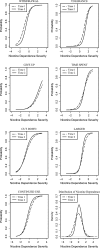Exploring the role of a nicotine quantity-frequency use criterion in the classification of nicotine dependence and the stability of a nicotine dependence continuum over time
- PMID: 20081041
- PMCID: PMC2825099
- DOI: 10.1093/ntr/ntp196
Exploring the role of a nicotine quantity-frequency use criterion in the classification of nicotine dependence and the stability of a nicotine dependence continuum over time
Abstract
Introduction: This study investigated (a) the utility of a cigarette quantity-frequency (QF) use criterion as an indicator for nicotine dependence (ND) and (b) the stability of the ND continuum of severity over time.
Method: Data from individuals who smoked cigarettes in the year prior to both time points of the National Epidemiologic Survey on Alcohol and Related Conditions were analyzed (n = 6,185). The Alcohol Use Disorder and Associated Disabilities Interview Schedule DSM-IV Version (AUDADIS-IV) assessed for DSM-IV ND and nicotine use. Three QF criteria were created to represent daily consumption of > or = 5 cigarettes, > or = 10 cigarettes, or > or = 20 cigarettes. Confirmatory factor analysis and item response theory analysis were used to explore the latent structure of ND. Differential item functioning (DIF) analysis investigated the stability of the ND continuum over time.
Results: A one-factor model, representing the DSM-IV conceptualization of ND, was an acceptable fit to the data at both time points. The inclusion of QF criteria decreased the fit of the one-factor model of ND. DIF in the severity and discrimination parameters of the diagnostic criteria was evident across the time points of the survey.
Discussion: Although QF of cigarette use is related to ND, it appears to be a separate construct. Researchers using the AUDADIS-IV should be aware that the characteristics of the DSM-IV ND criteria do vary slightly across time, even though the changes appear to be relatively small and of minor clinical or practical significance.
Figures
Similar articles
-
Reciprocal associations between cigarette consumption and DSM-IV nicotine dependence criteria in adolescent smokers.Addiction. 2014 Sep;109(9):1518-28. doi: 10.1111/add.12619. Epub 2014 Jul 16. Addiction. 2014. PMID: 24845775 Free PMC article.
-
Linking measures of adolescent nicotine dependence to a common latent continuum.Drug Alcohol Depend. 2009 Jan 1;99(1-3):296-308. doi: 10.1016/j.drugalcdep.2008.09.001. Epub 2008 Oct 19. Drug Alcohol Depend. 2009. PMID: 18938047 Free PMC article.
-
Measurement of multiple nicotine dependence domains among cigarette, non-cigarette and poly-tobacco users: Insights from item response theory.Drug Alcohol Depend. 2015 Jul 1;152:185-93. doi: 10.1016/j.drugalcdep.2015.03.040. Epub 2015 Apr 27. Drug Alcohol Depend. 2015. PMID: 26005043 Free PMC article.
-
Validity of proposed DSM-5 diagnostic criteria for nicotine use disorder: results from 734 Israeli lifetime smokers.Psychol Med. 2013 Oct;43(10):2179-90. doi: 10.1017/S0033291712002954. Epub 2013 Jan 14. Psychol Med. 2013. PMID: 23312475 Free PMC article.
-
Validity of the DSM-5 tobacco use disorder diagnostics in adults with problematic substance use.Drug Alcohol Depend. 2022 May 1;234:109411. doi: 10.1016/j.drugalcdep.2022.109411. Epub 2022 Mar 17. Drug Alcohol Depend. 2022. PMID: 35338898 Free PMC article.
Cited by
-
The genetics of addiction-a translational perspective.Transl Psychiatry. 2012 Jul 17;2(7):e140. doi: 10.1038/tp.2012.54. Transl Psychiatry. 2012. PMID: 22806211 Free PMC article. Review.
-
Commonalities and Differences Across Substance Use Disorders: Phenomenological and Epidemiological Aspects.Alcohol Clin Exp Res. 2015 Oct;39(10):1878-900. doi: 10.1111/acer.12838. Epub 2015 Sep 1. Alcohol Clin Exp Res. 2015. PMID: 26332166 Free PMC article. Review.
-
Examining sex differences in DSM-IV-TR narcissistic personality disorder symptom expression using Item Response Theory (IRT).Psychiatry Res. 2018 Feb;260:500-507. doi: 10.1016/j.psychres.2017.12.031. Epub 2017 Dec 14. Psychiatry Res. 2018. PMID: 29291575 Free PMC article.
-
DSM-5 criteria for substance use disorders: recommendations and rationale.Am J Psychiatry. 2013 Aug;170(8):834-51. doi: 10.1176/appi.ajp.2013.12060782. Am J Psychiatry. 2013. PMID: 23903334 Free PMC article. Review.
-
Nicotine dependence, abuse and craving: dimensionality in an Israeli sample.Addiction. 2011 Sep;106(9):1675-86. doi: 10.1111/j.1360-0443.2011.03484.x. Addiction. 2011. PMID: 21545668 Free PMC article.
References
-
- American Psychiatric Association. Diagnostic and statistical manual of mental disorders. 4th ed. Washington, DC: Author; 1994.
-
- Benjamini Y, Hochberg Y. Controlling false discovery rate: A practical and powerful approach to multiple testing. Journal of the Royal Statistical Society Series B. 1995;57:289–300.
-
- Bentler PM. Comparative fit indices in structural models. Psychological Bulletin. 1990;107:238–246. - PubMed
-
- Beseler CL, Shmulewitz D, Aharonovich E, Hasin D. DSM-IV alcohol abuse and dependence: An IRT analysis in Israeli household residents. Alcoholism: Clinical and Experimental Research. 2009;33(Suppl.):66A.
-
- Birnbaum A. Some latent trait models and their use in inferring an examinee’s ability. In: Lord FM, Novick MR, editors. Statistical theories of mental test scores. Reading, MA: Addison-Wesley; 1968. pp. 395–479.
Publication types
MeSH terms
LinkOut - more resources
Full Text Sources


